#codex wallerstein
Text

This is from the Codex Wallerstein, a medieval fighting manual. Please somebody who can read ye olde German tell me what technique this is supposed to demonstrate?
52 notes
·
View notes
Text
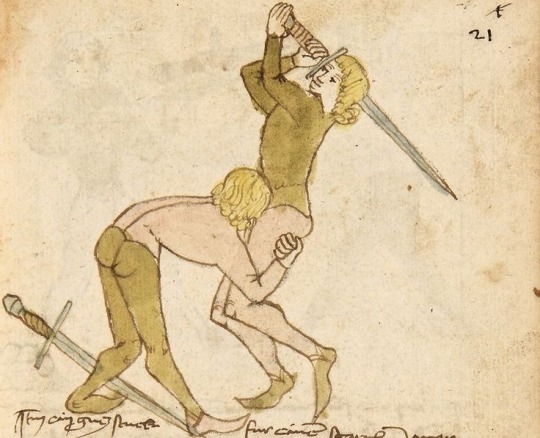
More: https://thetravelbible.com/top-artifacts-from-the-medieval-period/
An Illustration of a longsword technique from the Codex Wallerstein, a 16th-century convolution of three 15th-century fechtbuch (combat manual) manuscripts, with a total of 221 pages. The codex is now housed at the Augsburg University library in Germany
2K notes
·
View notes
Text
Codex Wallerstein btw ... a fencing manual from the 16th century. Lots of things about fencing to learn from it!
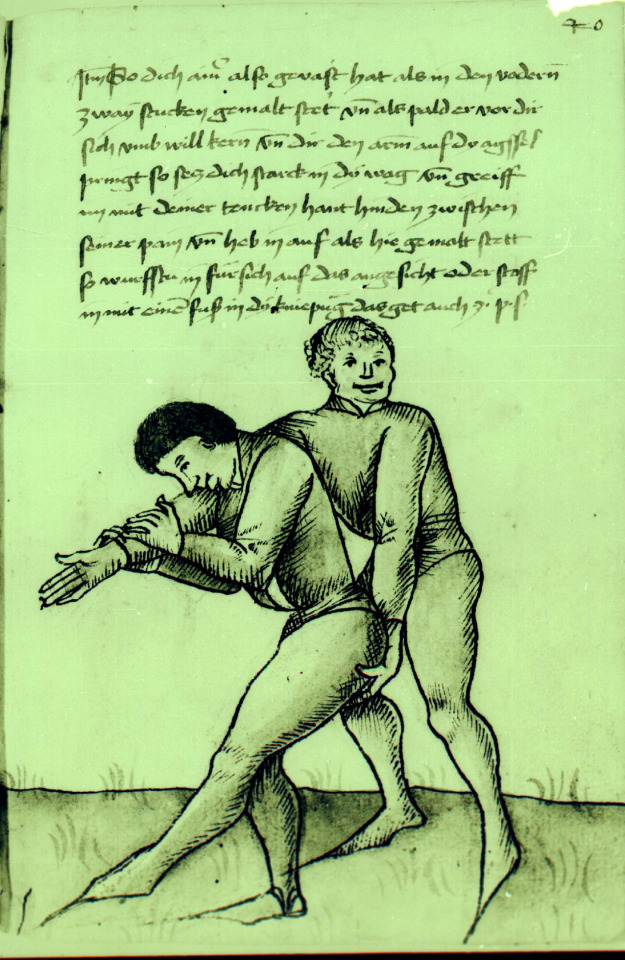
51 notes
·
View notes
Video
youtube
“ HEMA Bookshelf is a project run by Michael Chidester, who is also the creator and digital shepherd of the Wiktenauer (www.wiktenauer.com).
HEMA Bookshelf produces facsimiles of historical fencing manuals that are sure to enrich the sword community!
See below for video time stamps.
Not sure what a facsimile is or why you, as a historical martial artist, should care? Watch and find out!
Want to get your hands on a facsimile? Go to www.HEMAbookshelf.com
(not in the budget but still want to support HEMABookshelf? It’s always helpful to like and share their content on Facebook.)
Want to jump on the Bauman/Wallerstein fechtbuch facsimile before it starts trending? Here’s the indiegogo campaign: https://www.indiegogo.com/projects/bauman-fechtbuch-codex-wallerstein-facsimile#/
Patrons! Please use the secret link on patreon to get your discount for HEMAbookshelf!
⚔️❤️ Join me on Patreon for exclusive content, discounts, and more: www.patreon.com/saintleafy
0:18 What is a facsimile
2:00 HEMA Bookshelf
3:30 NEW facsimile project!
4:30 Look at the Lecküchner facsimile
6:40 Look at the Talhoffer facsimile
9:13 Where to get your own facsimile “
For anyone who hasn’t yet seen the following links:
Some advice on how to start studying the sources generally can be found in these older posts
Remember to check out A Guide to Starting a Liberation Martial Arts Gym as it may help with your own club/gym/dojo/school culture and approach.Check out their curriculum too.
Fear is the Mind Killer: How to Build a Training Culture that Fosters Strength and Resilience by Kajetan Sadowski may be relevant as well.
“How We Learn to Move: A Revolution in the Way We Coach & Practice Sports Skills” by Rob Gray as well as this post that goes over the basics of his constraints lead, ecological approach.
Another useful book to check out is The Theory and Practice of Historical European Martial Arts (while about HEMA, a lot of it is applicable to other historical martial arts clubs dealing with research and recreation of old fighting systems).
Trauma informed coaching and why it matters
Why having a systematic approach to training can be beneficial
Why we may not want one attack 10 000 times, nor 10 000 attacks done once, but a third option.
How consent and opting in function and why it matters.
More on tactics in fencing
Open vs closed skills
The three primary factors to safety within historical fencing
Worth checking out are this blogs tags on pedagogy and teaching for other related useful posts.
And if you train any weapon based form of historical fencing check out the ‘HEMA game archive’ where you can find a plethora of different drills, focused sparring and game options to use for effective, useful and fun training.
For more on how to use youtube content for learning historical fencing I suggest checking out these older posts on the concept of video study of sparring and tournament footage.
Consider getting some patches of this sort or these cool rashguards to show support for good causes or a t-shirt like to send a good message while at training.
20 notes
·
View notes
Text
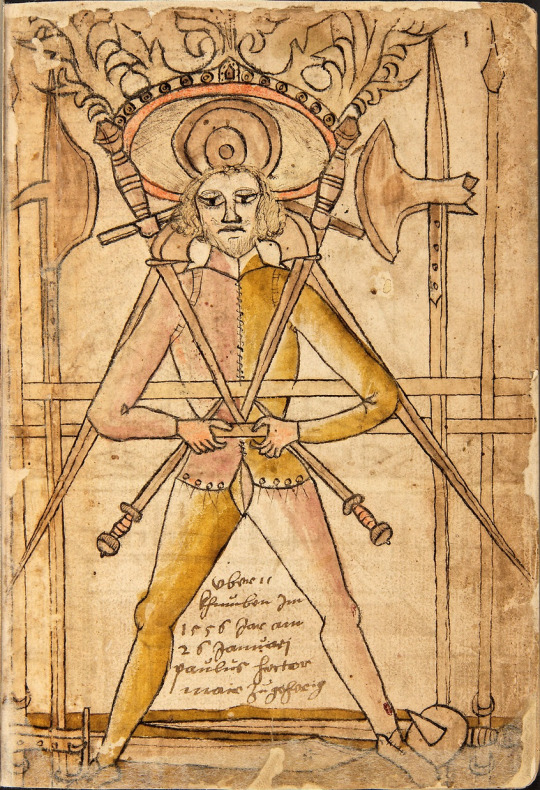
First page of Codex Wallerstein, depicting a fencer surrounded by various arms. This page comes from the parts of the manuscript dated circa 1420; a note by a later owner is inscribed between the legs of the fencer, dated 1556
5 notes
·
View notes
Text
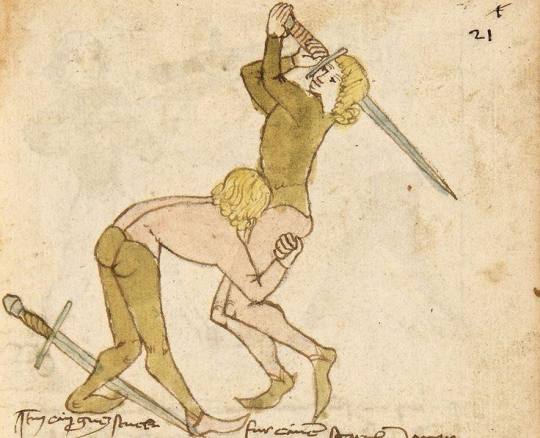
An Illustration of a longsword technique from the Codex Wallerstein, a 16th-century convolution of three 15th-century fechtbuch (combat manual) manuscripts, with a total of 221 pages. The codex is now housed at the Augsburg University library in Germany
1 note
·
View note
Text

An Illustration of a longsword technique from the Codex Wallerstein, a 16th-century convolution of three 15th-century fechtbuch (combat manual) manuscripts, with a total of 221 pages. The codex is now housed at the Augsburg University library in Germany
The original inscription says in Latin "If you are fighting swords and you drop your sword, be quick and bite his weiner. Or if you are so inclined, make him your best friend with mouth pleasure"
I read medieval Latin.
0 notes
Text

When you are having a fencing duel but he decides to go for the "suprise blowjob" move.
(Illustration from the Codex Wallerstein)
2 notes
·
View notes
Photo
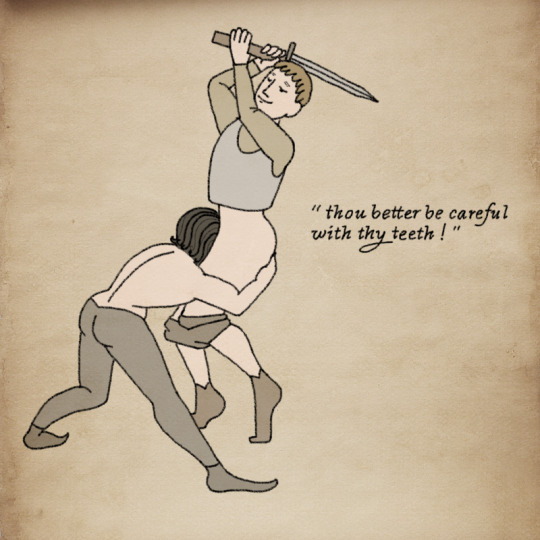
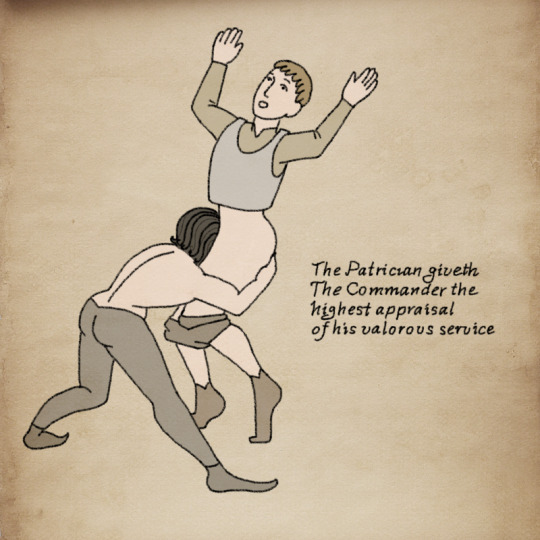
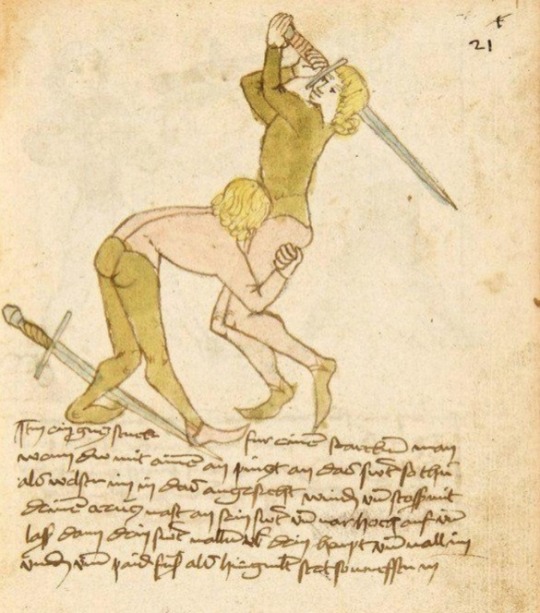
Two more sleezy pictures about the patrician and the commander that are spread around the Shades
I bet Vetinari collects the best exemplars
(the third picture is a part of Codex Wallerstein - fencing manual that dates back to 16th century)
15 notes
·
View notes
Photo

More bind work! Here is @alexander.j.williamson in mid-movement coaching Aislin (a new student) on the Zornhau-ort, a cut which sets up a thrust along the opponent’s #blade. The second image is a similar bind from the Codex Wallerstein. #yyc #calgary #alberta #canada #yycmartialarts #martialarts #medival #sword #fight #swordfight #fun #hema #longsword #summer #park #instagood #fencing #picoftheday #training #practicemakesperfect (at The Forge: Western Martial Arts) https://www.instagram.com/p/CSpzRV0JAaF/?utm_medium=tumblr
#blade#yyc#calgary#alberta#canada#yycmartialarts#martialarts#medival#sword#fight#swordfight#fun#hema#longsword#summer#park#instagood#fencing#picoftheday#training#practicemakesperfect
1 note
·
View note
Video
youtube
elsegno:
Love me a good high energy dagger video
0 notes
Text
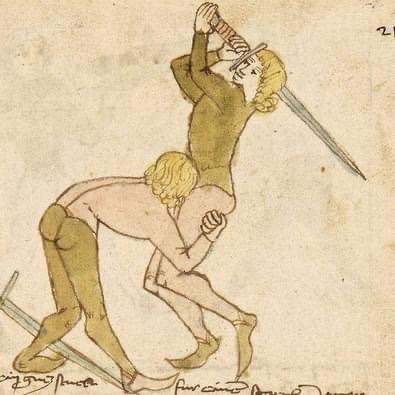
An Illustration of a longsword technique from the Codex Wallerstein, a 16th-century convolution of three 15th-century fechtbuch (combat manual) manuscripts, with a total of 221 pages. The codex is now housed at the Augsburg University library in Germany
More: https://bio.link/museumofartifacts
162 notes
·
View notes
Photo

IDK guys I think I'm getting the hang of this translating fechtbuchs thing.
#swords#german longsword#hema#historical fencing#historicaleuropeanmartialarts#codex wallerstein#joe does stuff
0 notes
Video
youtube
“ 0:00 - 1. Head Inside Standing Double Leg 2:17 - 2. Head Inside Knee Drop Double Leg 4:09 - 3. Head Outside Knee Drop to Standing Double Leg 5:34 - 4. Head Outside Knee Drop to Angle Cut Double Leg 5:43 - 5. Head Outside Orthodox to Southpaw Standing Double Leg 6:32 - 6. Head Outside Standing Double Leg 7:15 - 7. Following Up After Double Leg “
The video is focused on material meant for modern audiences interested in grappling and/or MMA, however this type of takedown is present across different martial arts and periods, including many historical systems.
Folio 21r of the Codex Wallerstein is a type of a double leg takedown, and it’s present in Meyer’s system as well as just a couple of examples.
Here’s an older post going a bit more in-depth in regards to Meyer’s and other historical versions of the technique.
Also importantly the video showcases a number of different variations of positioning, tactics and leverages one can use to achieve the overall technique.
Being able to adapt to changing circumstances was relevant no matter what grappling system you trained with historically, even if sometimes the ‘rules of engagement’ may have been different.
In case you’re interested in historical forms of grappling and wrestling check out
Ringen discussiongroup! as well as HEMA Grapplers and Scholars of Fiore dei Liberi.
For anyone who hasn’t yet seen the following links:
Some advice on how to start studying the sources generally can be found in these older posts
Remember to check out A Guide to Starting a Liberation Martial Arts Gym as it may help with your own club/gym/dojo/school culture and approach.
Check out their curriculum too.
Fear is the Mind Killer: How to Build a Training Culture that Fosters Strength and Resilience by Kajetan Sadowski may be relevant as well.
“How We Learn to Move: A Revolution in the Way We Coach & Practice Sports Skills” by Rob Gray
Another useful book to check out is The Theory and Practice of Historical European Martial Arts (while about HEMA, a lot of it is applicable to other historical martial arts clubs dealing with research and recreation of old fighting systems).
Why having a systematic approach to training can be beneficial
Worth checking out are this blogs tags on pedagogy and teaching for other related useful posts.
And if you train any weapon based form of historical fencing check out the ‘HEMA game archive’ where you can find a plethora of different drills, focused sparring and game options to use for effective, useful and fun training.
Consider getting some patches of this sort or these cool rashguards to show support for good causes or a t-shirt like to send a good message while at training.
And stay safe
9 notes
·
View notes
Text
Einlegen
A counter to a twerhau which shows a common connection between Talhoffer, Codex Wallerstein, and the Ringeck/Danzig lineage.
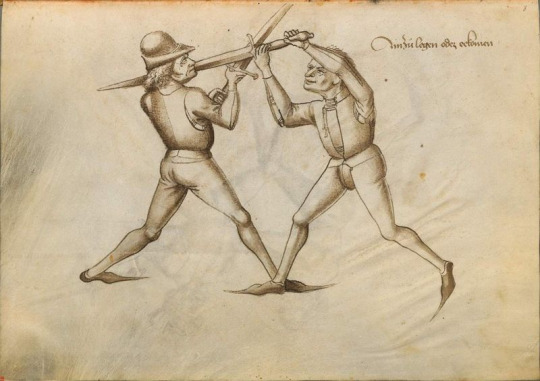
Ain zu legen oder eekomen.
A laying-to or to come before.
Talhoffer 1467
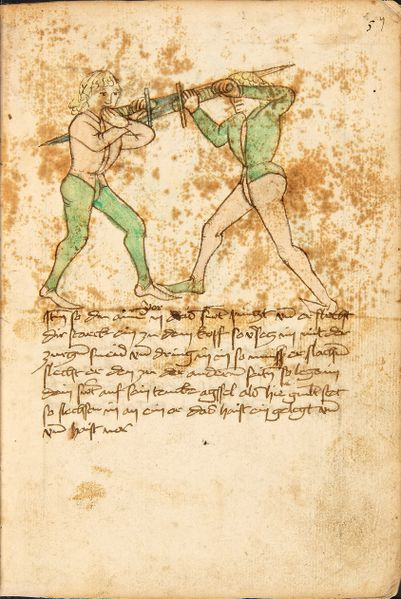
Vor.
Item so du ainen in das swert pinczt (bindest) und er slecht dir starck ein zu dem kopf, so versecz in mit der zurczen (kurzen) sneid und dring in in, so muß er slachen. Slecht er den zu der andern seiten, so lege im dein swert anf sein tencke agssel, als hie gemalt stet, so slechstu im an ein or. Das haist eingelegt und haist vor.
Vor.
Now, if someone binds with you on the sword and he strikes strongly in to your head, then displace him with the short edge and close in so he has to strike. If he strikes to your other side, then lay the sword on his left shoulder as it is shown here, and you hit him in the ear. This is called laying-in and is called the Vor.
Codex Wallerstein (1460s-1470s?)
Hie merck die pruch wider den twer haw
|Merck |wenn dw gegen ÿm stest in der hu°t vom tag |So haw ÿm künlich oben ein zu° dem kopff springt er denn aus dem haw |vnd maint er wöll vor kume~ mit dem twer haw |vnd slecht dir do mit zw° deiner lincken seitten zw° dein kopff |So val ÿm mit der langen schneid auff das swert |Slecht er denn mit [19v] der twer aber vmb dir zu° der anderñ seitten |So küm dw Indes vor auch mit der twer vorñ für vnder seine~ swert im an den hals |So slecht er sich selber mit deinem swert ~
Here note the break against the twerhau.
Remember: when you stand against him in vom tag, then cut bravely from above to the head. If he then springs out to come well before, striking with a twerhau to the left side of your head, then fall in with the long edge on his sword. If he then strikes around with a twer to the other side, then come also in that moment with the twer before him, underneath his sword (in front of it) on the neck, so he strikes himself with his own sword.
Pseudo-Danzig, 1452
The description from Sigmund Ringeck is almost exactly the same as Pseudo-Danzig’s. Here is (a copy of?) his illustration.
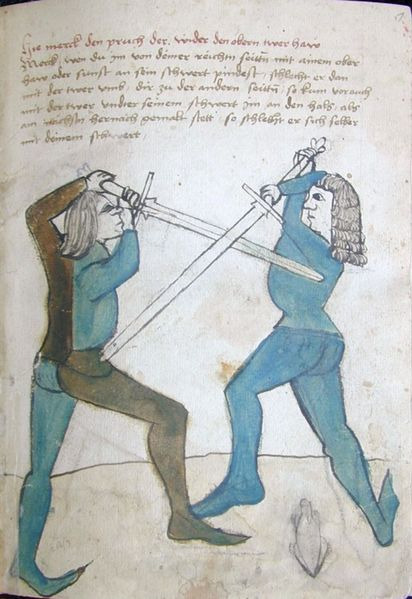
56 notes
·
View notes
Photo
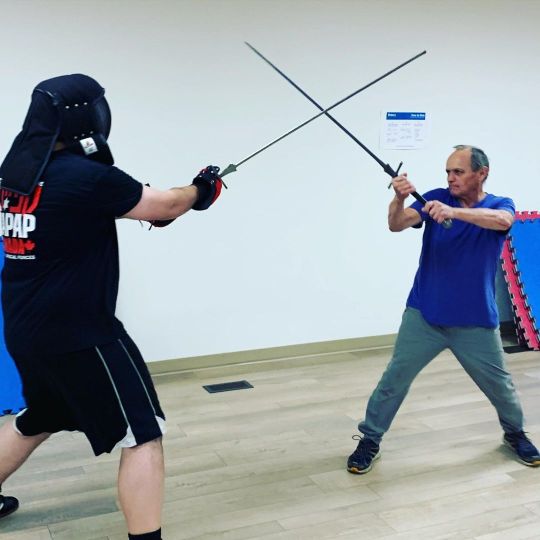
Here’s a frame by frame analysis of the Mutieren we covered on Thursday: Tavis (left) and Murray entered a bind caused by the intersection of their diagonal descending cuts from their right shoulders (images 1 and 2). Murray then exerted lateral pressure against Tavis’ blade. This prompted Tavis to execute the Duplieren (detailed in previous posts). In response, Murray performed a hanging parry (images 3 and 4). Feeling that the bind pressure had lessened due to the parry, Tavis executed the Mutieren by winding his short (back) edge against Murray’s blade, thereby controlling it, and then stabbed Murray in the ribs from the outside (images 5 - 7). Historical images from the Codex Wallerstein (ca. 1470), and the Goliath Manuscript (ca. 1540). #yyc #calgary #alberta #canada #yycmartialarts #martialarts #hema #fencing #sword #fight #swordfight #sport #medieval #longsword #blade #training #renaissance #fun #instagood #people #theforgewma #blade #history #swordsmanship #kenjutsu #practicemakesperfect (at The Forge: Western Martial Arts) https://www.instagram.com/p/CU0SmdZpluT/?utm_medium=tumblr
#yyc#calgary#alberta#canada#yycmartialarts#martialarts#hema#fencing#sword#fight#swordfight#sport#medieval#longsword#blade#training#renaissance#fun#instagood#people#theforgewma#history#swordsmanship#kenjutsu#practicemakesperfect
0 notes